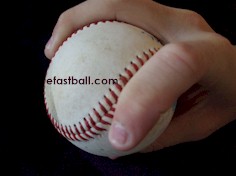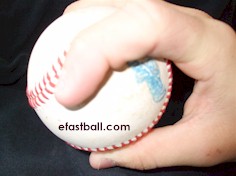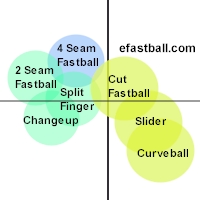How to Grip a Split Finger Pitch



Right Handed Pitcher
Updates
- 6/13/13 - Removed reference to 'changeup' in title, included some forkball differences, and updated splitter pitcher list
- 8/08/08 - Added Hitter view chart
- 5/29/08 - Initial post with grip images
AKA
This grip is called a splitter or a split finger pitch. (This is not a forkball)Position the Ball
Two seam fastball direction Turn the ball where the seams run the direction of your fingers and the horseshoes (the "U") are close together.Position your fingers
Place your first two fingers (index and middle fingers) outside the seams, but not the full width of the ball like a forkball.Position your thumb
Place your thumb directly under the ball on the smooth part of the baseball (no seam).Exert Pressure
Squeeze the ball with your thumb pushing against the inside of your index and middle fingers.Delivery and Release
This pitch is delivered and released just like a 2 seam fastball.Your hand will pronate (thumb down, inward, clockwise LH, counterclockwise RH) slightly.
This rotation is the same as a four seam fastball, and the opposite rotation of a curveball.
Compared to other grips
This pitch is moves more and is slightly slower than a 2 seam fastball, but is faster and moves less than a changeup.The ball does not break hard to the side like a cutter or a slider, but instead drops straight down (or barely to the right) like a palm ball.
For a forkball, the fingers are spread the full diameter of the ball, so you can't 'pull down' on the ball, creating backspin like a splitter.
What the hitter sees
This ball appears as a two seam fastball, then it drops more than he expects.The two seams appear to the hitter as two vertical lines.
Alternate grip
Rotate the ball backwards to the typical two seam position, the seams are closest together. Use the same finger and thumb positions.When to throw
This is a difficult pitch to master and is hard to locate.It is not generally thrown to land in the strike zone, but will instead drop out of the zone in the last 15 feet in flight.
What it does (movement)
The ball will move down as late as possible move slightly to the right for a right handed pitcher. For a left hand pitcher, it moves down and slightly to the left.The ball creates a slow easy spin and rotates from bottom-to-top as viewed by the hitter. It should rotate slower than a two seam fastball.
Reaction Time
The hitter has roughly 0.40 to 0.45 seconds to hit this pitch.Typical Speed
This pitch is slightly slower than a 2 seam fastball (6-7 mph slower in MLB).| 10 and under | 35-45 mph |
| 11-12 | 45-55 mph |
| 13-14 | 50-70 mph |
| High School | 70-80 mph |
| College/ Pro | 75-90 mph |
The ball will typically slow down 8-10 mph by the time it reaches the front of the plate. (Note that your home radar gun may stop reading well before the ball reaches the plate because the hitter is in the way.)
